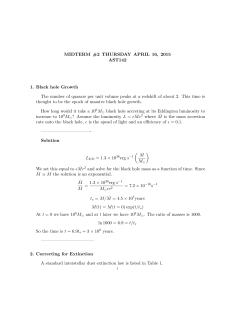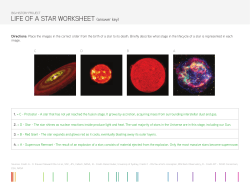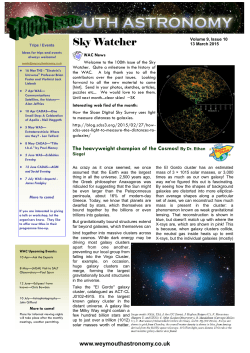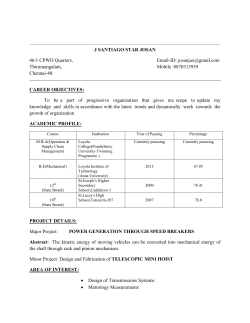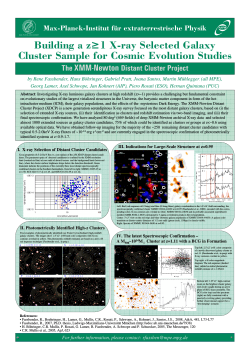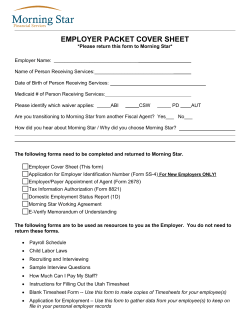
Spring AstroCamp 2015 Welcome_Pack
SPRING 2015 WELCOME TO ASTROCAMP It’s our aim to continue the AstroCamp tradition of being the friendliest and most helpful star party there is. So, if you’re feeling sociable, come and set up around 'The Common', near the reception and the AstroCamp HQ tent. If you want to look through a range of scopes or ask questions, 'The Common' is the place to come! In this pack, you find a guide to the scheduled events and talks that will will be taking place this AstroCamp. All talks, events & workshops are included in your admission, so please feel free to come along to any or all that you’d like. We've also listed five objects each, as a starter for planning your observations over the weekend. week All the observation times are listed in UK local time. Apart from the Astronomers in the Pub event on Saturday afternoon, all workshops will begin from the AstroCamp HQ tent on 'The Common'. Having outgrown the pub, the Sunday afternoon talks & quizzes quizzes will be held at Cwmdu Village Hall. This is easy to find: from the Farmer’s Arms pub, continue north on the A479 and turn left after 140m. All events are free. HOW TO GET TO ASTROCAMP AMP By Train: The nearest train station to Cwmdu is Abergavenny. Bus services run weekly to Cwmdu so booking a taxi from the train station is recommended. Taxis Taxi cost around £25 each way, but most operators seem to be happy to negotiate a fixed price if you guarantee that you will use them for the return journey. jou By Car: Cwmdu Caravan & Camp site is located four miles north of Crickhowell just off the A479 Turn right at the Farmers Arms public house in the small village of Cwmdu and follow the signs for 300m. PLEASE NOTE: While SATNAV may bring you successfully successfully to the area it may NOT deliver you to the campsite. Please follow the "camping" road signs from the Farmers Arms public house for the final 300m to the campsite. Campsite Address: Cwmdu Campsite, Cwmdu, Crickhowell, Powys, NP8 1RU CAMPSITE LAYOUT Unless pitching in the 'Unallocated Pitching' section, please pitch in your allocated area according to the map below. ASTROCAMP EVENT SCHEDULE Saturday 9th En route to Cwmdu, listen to the Awesome Astronomy special podcast extra just for AstroCampers! 13:00 ............... Arrive at campsite, pitch up & set up. 17:00 ............... Meet & Greet. Come to the gazebo on The Common to meet new friends, share stories & a drink or two. 18:00 ............... John’s collimation workshop on The Common - to help make sure your scope’s mirrors are perfectly aligned for 3 nights of stargazing. 21:00 ............... Paul’s star hopping & navigating tutorial on The Common. Learn how to find your way around the sky. Sunday 10th 10:00 ............... Eric’s Solar SUN-day - solar observing in white light and hydrogen alpha on The Common. Once again, we'll be holding the Sunday afternoon talks and quizzes at the Cwmdu Village Hall. We have a licence to sell ale, cider, lager and wine at the Village Hall but you’re welcome to bring your own drinks. 14:00 ............... The main Astronomy Pub Quiz - keep your teams small as you won’t want to share the prizes! 14:45 ............... Guest talk - astronomer Nick Howes takes us on an exploration of Comets: Cool and Catastrophe... history of exploration and fear. 15:30 ............... The Champions of the Universe Quiz - for those who want to really show off what they know. And you're playing for beer. 16:00 onward .. we have the village hall all day, so people are welcome to stay and socialise. We'll close it in time for people to get their scopes set up before nightfall and for Pat's tutorial. 19:00 ............... Pat’s equatorial GOTO setup tutorial on The Common. Monday 11th 14:00 ............... High Tea on 'The Common'. Bring food, drinks, (guitars?), chairs & tables if you have them, for this social gathering that proves so popular each year. 17:00 ............... Pat's "Considerations When Buying Your First Telescope" tutorial on The Common. Tuesday 12th 12:00 ............... Leave campsite & book for 19th-22nd September 2015! NIGHTLY SPECTROSCOPY DEMONSTRATION This camp Damien will be giving demonstrations of amateur stellar spectroscopy. Including explanations of the equipment and software needed, as well as what you can learn from the spectral profiles that are generated. The demonstrations will be held nightly, just after dusk, at the bottom of 'The Common'. GUEST SPEAKER - NICK HOWES Nick Howes is an amateur astronomer, former deputy director of the Kielder Observatory and freelance science writer whose work has included the European Space Agencies Science Portal and NASA Blueshift. A Fellow of the Royal Astronomical Society, he has written for Astronomy U.S, Sky and Telescope, Popular Astronomy, Spaceflight and many other publications and websites, including major work for the world’s largest telescope project, the Square Kilometre Array. A speaker at international conferences, he has shared the stage with Apollo astronauts, NASA MSL teams and some of the world’s leading experts in comet research. His images of comets and asteroids have graced the NASA home pages on multiple occasions. Have won awards and been featured by the like of National Geographic, The Times, Universe Today, Space.com, The Financial Times and Discovery Channel Science as well as multiple books and peer reviewed journals. For 5 years, Nick was the Pro-Am Programme Manager for the twin 2-metre Faulkes Telescopes, where he coordinated projects with the European Space Agency on their near Earth object program, ESO on massive star cluster observations and NASA’s comet observing campaigns as well as projects with the U.S based Space Science and Planetary Science Institutes monitoring a range of comets and their activity. With the Planetary Science Institute and Space Science Institute teams Nick works on observations he makes with large robotic telescopes around the globe focusing on comets and their morphology. He also contributes data to the Italian CARA comet research group on dust measurements for cometary bodies. Nick has over 430 NASA ADS citations for observational work on comets and asteroids, and is in the Guinness Book of records for leading a team of UK Astronomers in creating the World’s largest image composite of the Moon taken by ground based observations. A STEM ambassador in the UK, he has appeared on both BBC television and radio and he regularly features as the official astronomer for the BBC in the South West of England. He is also the tour leader for astronomy holidays in Africa and Oman and was technical consultant to the GEO Observatory in Andalucía, Spain. RALPH'S DSO IMAGING TARGETS FOR BEGINNERS My picks are all visible in a 4” (100mm) scope and can be imaged in 1 minute exposures with a tracking mount. With a good polar alignment, you may be able to take 3 minute exposures or longer. But look at them carefully and if the stars look like they’re smearing, discard them and take slightly shorter exposures or refine your polar alignment. Come and ask me if you have any imaging questions and any of the imagers on site will be happy to give you pointers if you’re new to astrophotography. M13 - THE GREAT GLOBULAR CLUSTER IN HERCULES High up in the east, and well placed to observe or image as soon as it’s dark, Messier 13 sits roughly two thirds the way along a line imagined between the stars Zeta and Eta Herculis in the keystone shaped asterism in Hercules. This is the largest and most spectacular globular cluster for northern hemisphere observers. M13 is a gravitationally bound ball of more than a quarter of a million stars, 22 light years away in a halo around our galaxy. This wonder has become a firm AstroCamp favourite. A one minute DSLR exposure from an alt/az or equatorial mount will show dozens of individual stars. If you have an equatorial mount, try taking longer exposures or stacking lots of 1 minute exposures in Deep Sky Stacker - don’t worry if you’ve never tried stacking images before, we’ll be happy to show you and you’ll be surprised at how much detail you can reveal. NGC 869 & 884 - THE DOUBLE CLUSTER Dipping in the sky, so better to image or observe as soon as it’s dark, The Double Cluster can be found by locating Gamma Cassiopeia (the apex in the centre of the ‘W’ shape of the constellation anytime after darkness sets. Draw a line from Gamma Cassiopeia to Ruchbah at the bottom left hand dip in the ‘W’ and follow that line for the same distance. You’ll almost certainly see a large faint smudge of light with the naked eye. Using a small scope or binoculars will show it as two pretty star clusters in the same field of view. They’re actually moving towards us at 25 miles per second but, luckily, it’ll take 13 million years to get anywhere near us! As with M13, a one minute exposure with a DSLR fixed to a scope will easily reveal the mass of stars in these two clusters. Multiple images stacked in Deep Sky Stacker will be almost as good as taking much longer exposures. M51 - THE WHIRLPOOL GALAXY Perhaps the most mesmerising of the brighter galaxies, Messier 51 lets you see two galaxies merging high up in Ursa Major all night. The dark skies of Cwmdu will let you see the famous Whirlpool Galaxy at its very best and 1 minute DSRL exposures will show you far more detail as these two monsters enter their inevitable death spiral. Find the star Alkaid – the first star in the handle of the plough. Trace a line to the next bright star to the right, Cor Caroli. About a quarter of the way and just above that point along the line to Cor Caroli sits a unique wonder for amateur astronomers. VENUS As inferior planets (planets that orbit closer to the sun than Earth), many people are often surprised to see Venus and Mercury with a ‘phase’. The outer planets always show a fully illuminated globe but the inferior planets often look more like a small moon than a planet. In fact during AstroCamp, Venus will be showing a 63% lit gibbous phase – much as our moon does each month. Venus will be the first ‘star’ you’ll see as the sun sets as it’s far brighter than all the stars and 6 times brighter even than Jupiter. Look West and you won’t miss it until it sets around midnight. Being so bright Venus is best imaged with a fast frame rate planetary camera or webcam but a fast shutter speed setting on a telescope mounted DSLR will let you grab a very good image of the second planet and catch that Venusian gibbous phase. I’d recommend a low (200/400) ISO and shutter speed of 1/250 as a starting point, but adjust the shutter speed to get the exposure just right. COMET C/2014 Q2 (LOVEJOY) With a few faint comets around in May 2015, it would be remiss of us not to give you the opportunity to take a snap of one. The brightest one at the moment is Comet Lovejoy, which would have been naked eye visible under Cwmdu’s skies in February but is now fading. Saying that, Lovejoy’s still visible in binoculars and small telescopes and that makes it ideal to take an image of too! To find Lovejoy, look north for the simple house-shaped constellation of Cepheus and the star in the apex of the roof, Errai. Follow the point of the house through Errai for about the width of your outstretched hand and Lovejoy should be in the field of view. A one minute exposure with a DSLR on a telescope should show you the fuzzy ball of the comet’s nucleus. Under these dark skies you may even record the green hue caused by diatomic carbon venting from the comet. If you stack 5 or 10 one minute exposures in Deep Sky Stacker, you’ll see even more detail. PAUL'S VISUAL DSO HUNT For this camp I am going to suggest a tour through what looks like a pretty unremarkable pair of constellations, both with odd names, Canes Venatici and Coma Berenices. What these constellations lack in readily identifiable shape and size they more than make up for in deep sky targets, between them they contain 13 Messier objects! M94 I have chosen a series of targets to draw you through these neighbouring constellations and we start with an object that sits between and above the two main stars of Canes Venatici, Cor Caroli and Chara. These stars are quite close together and forming a flat triangle with them is galaxy M94. This is a tightly wound spiral with a magnitude of 8.2 making it slightly brighter than that most famous of Canes Venatici galaxies M51 and at 14 million light years distant it less than half the distance of the whirlpool. Small telescopes in a dark sky will start to get a hint of the spiral arms, medium and large telescopes will certainly be able to tease out the detail. COR CAROLI Before moving on to our next target do take a look at the star Alpha Venaticorum, or Cor Caroli - which means Charles’ Heart and is named for one of the two King Charles’ in the 17th Century though there is debate about which. You will see that it is an easily resolved double with the brighter of the pair being a curious variable that is believed to dim due to enormous starspots that cross its surface. M3 Our next DSO is M3, a globular cluster that is thought to be the Messier original (despite being designated 3) and is the object which pushed the comet hunter to create his famous catalogue. It is a bright cluster but one that can be hard to locate as there is no easy bright star nearby. If you locate Arcturus by following the handle of the plough and curving down, then following a line back to Cor Caroli you should be able to locate M3 not quite half way along that line. It is bright so is not easily missed and is visible in your finder scope if you are paying attention. This is perhaps one of the best globs in the northern hemisphere and is magnitude 3.2 despite being almost 34,000 light years away COMA BERENICES CLUSTER Now it is time to look for our next constellation and like Canes Venatici, Coma Berenices is not a stand out bright group of stars. But one good signpost in a dark sky is the naked eye cluster known as the Coma Berenices Cluster. This is about 250 light years away and can be seen as a fuzzy area of stars about half way between Cor Caroli and Denebola in Leo. This represents the hair of Queen Berenice of Egypt. You should be able to locate the three main stars of the constellation forming and upside down L shape. NGC 4565 - NEEDLE GALAXY Using the cluster as a reference you should be able to locate our next DSO to the east of it about halfway down the cluster. Here you will find a spectacular edge on spiral galaxy that in medium telescope will show a dark dust lane and a bright central bulge. M64 - BLACK EYE GALAXY From NGC 4565 draw a line to the brightest star in the constellation Alpha Comae Berenices, the one nearest Arcturus and the opposite end of the ‘L’ to the cluster. You should be able to locate a star called 35 Comae and M64 is very close. This galaxy is the famous Black Eye Galaxy and even in a small telescope a darker region in the centre will be revealed. This galaxy is magnitude 8.5 and is just 19 million light years away which makes it far closer than the Virgo Cluster. M53 AND NGC 5053 The last object is one that often gets overlooked because of the presence of so many galaxies. M53 a globular cluster is easily located near Alpha Comae and should be in your finder scope if you place it on Alpha Comae and nudge it slightly to the east by about 1 degree. Here you will find 100,000 stars in a ball 300 light years across about 65,000 light years away. As a bonus, move your scope a just over a degree to the southeast and see if you can locate the faint globular NGC 5053. This is a globular that has been disputed as a such in the past but is now been firmly proved to be a globular cluster, though lacking that bright central core. There is some evidence that it was a globular of the Sagittarius Dwarf Elliptical galaxy that is currently in the process of merging with the Milky Way. DAMIEN'S SOLAR SYSTEM ROUND UP MERCURY (ALL TIMES IN BST) DIAMETER: 8.6" MAGNITUDE: 0.8 Look to the west at dusk to spot the 'Messenger of the Gods' hot on the track of the setting Sun. Just past the most easterly point in its orbit, Mercury should be visible for about an hour before it sets behind the hills. Rise: Day Culmination: Day Set: 22:24 VENUS DIAMETER: 17.9" MAGNITUDE: -3.7 Venus is currently sitting in the constellation of Gemini, just under 3° from 1 Geminorum. At magnitude -3.7 , you don't need a star chart to find it, just look west at dusk! Filters: #25 red or #38A dark blue to bring out the upper clouds. Rise: Day Culmination: Day Set: 00:17 JUPITER DIAMETER: 36.8" Jupiter is currently sitting in Cancer, and can be spotted easily by looking SSW at dusk. Filters: Blue to bring out rills, festoons and the GRS, dark blue for the belts and GRS. Rise: Day Culmination: Day Great Red Spot Transits: 9th Start: 20:45 Midpoint: 22:45 11th Start: 22:30 Midpoint: 00:30 Moon Transits: 10th Europa Set: 01:40 End: 00:45 End: Jupiter Set Start: 20:01 End: 22:58 Moon Shadow Transits: 10th Europa Start: 22:31 End: 01:31 Moon Occultations: 10th Ganymede End: Jupiter Set Start: 22:51 MAGNITUDE: -1.64 SATURN DIAMETER: 18.5" MAGNITUDE: 0.28 Saturn is currently sitting in the constellation of Scorpius so don't expect it to get very high in the sky this season, or for most of the next decade! Don't let that get you down though, the rings have increased in tilt since last apparition to 24.5° providing a fantastic view. Filters: Blue to highlight the cloud bands and poles, yellow-green for the Cassini division. Rise: 23:05 Culmination: 02:06 Set: Day 2 PALLAS DIAMETER: 0.3" MAGNITUDE: 9.31 DIAMETER: 0.1" MAGNITUDE: 9.69 2 Pallas is the second asteroid to have been discovered, in 1802 by Heinrich Olbers. It was initially categorised as a planet, until the discovery of other many other asteroids in the 19th century, leading to their reclassification. Pallas is one of the largest asteroids and accounts for 7% of the mass of the asteroid belt. You can locate it by drawing a line between Omicron Herculis and Rasalhague, 2 Pallas can be found approximately two fifths of the way along it., close to the 5.6 magnitude star HIP 87777. Rise: 21:20 Culmination: 03:58 Set: Day 3 JUNO The third asteroid to be identified, 3 Juno accounts for 1% of the mass of the asteroid belt. It was discovered in 1804 by the astronomer Karl Harding. Juno can be found directly below Jupiter, not far off the line between Acubens and Asellus Australis in Cancer. Rise: Day Culmination: Day Set: 01:00 COMETS 22P/KOPFF AND C/2013 A1 SIDING SPRING The In addition to comet Lovejoy mentioned by Ralph, there are two other comets that will be visible from AstroCamp. Although at magnitudes of 13 and 12, these will be out of reach of small to medium scopes and are more suitable for imagers. Comet Siding spring is located two thirds of the way between Dubhe in Ursa Major and Edasich in Draco on the 9th. Comet Kopff can be located by drawing a line between Sigma Virginis and Nu Virginis. The comet will be located just above a point a third of the way along. STAR CAMP ETIQUETTE LIGHTS Please only use red light torches at night. If you use a laptop, please cover the screen with a sheet of red acetate. Toilet block lights will be switched off or covered in red acetate during the dark hours. We discourage the use of laser pointers as they'll interfere with astroimaging and can be dangerous. Also, cigarette lighters produce light as well as heat. Please screen your lighter flame from astronomers. Please be aware that lights inside tents and caravans are also visible to people outside of them - red lights or no lights please. This is the one piece of etiquette that will make offenders very unpopular - dark adaption takes up to half an hour to achieve but only a second of normal light will take you back to square one. EQUIPMENT People will be happy to let you look through the eyepiece of their scopes but please do ask the owner before taking a look. Be aware that telescopes are carefully aligned and assembled and as little contact to see through them is best. Be mindful of astroimagers. Astrophotography requires very steady and unobscured exposures, so please don't touch or walk in front of a scope being used for imaging. We will try and set aside an area for astroimagers for this very purpose. I'm told they're still a very friendly bunch despite their obsession with long exposures! CARS No car movements are permitted after dark, so please arrange to arrive before this time. Remember that opening car doors or the boot always turns an interior light on so disable them if you can, or remove the fuse before sunset. Alternatively, cover them with opaque tape, including those in the boot. If a bright light is unavoidable call out: “LIGHTS IN 3 SECONDS” to give everyone time to turn the other way. The best advice here is to remove everything you'll need from cars before nightfall and don't return to them. CHILDREN Children are welcome to the event, but please remember the field is dark, there are lots of very valuable bits of equipment and many people will have carefully aligned their telescopes. Also, tired astronomers are often glad of a lay in the following morning. Please keep your children and their volume under control. NOISE We want this to be an astronomy party, but please be considerate of others and refrain from any raucous behaviour or loud talking. Some people will want to catch up on some sleep for a few hours during the night and others will be sleeping during the day. Please be considerate of others trying to sleep when it is cloudy by not playing music late at night. RUBBISH The site is rich in wildlife and a very pleasant place to stay. We would like to keep it that way. Please keep your rubbish in a suitable container and dispose of it in the bins provided. Dark sites and loose rubbish do not mix well. DOGS Well behaved dogs are welcome to the event, but please remember the field is dark, there are lots of very valuable bits of equipment and many people will have carefully aligned their telescopes. Also, tired astronomers are often glad of a lay in the following morning. Please keep your dogs on a lead if they are anywhere near other people’s equipment and barking under control. Please also be mindful of others who might have a fear of dogs. CAMPSITE PERMANENT PITCHERS While we have exclusivity of the campsite regarding regular pitches, there will be some non-astronomer campers at the site who have permanent pitches. The campsite owners have done their best to make sure that they are aware of the star party etiquette, but in very rare circumstances they may be unable to keep a light off when visiting the facilities. Please be respectful towards them.
© Copyright 2025

